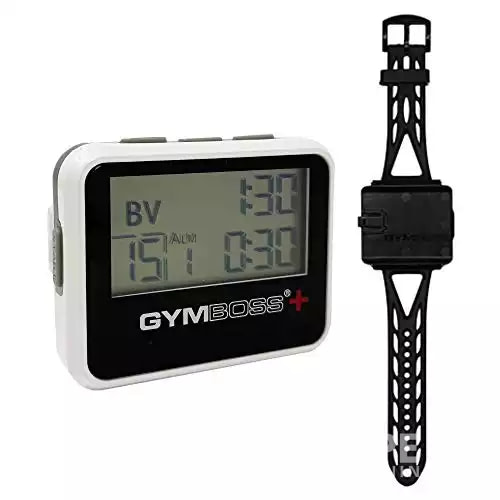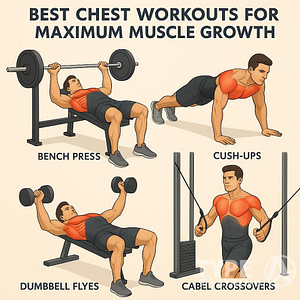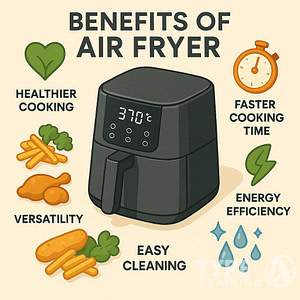AMRAP, which stands for “as many reps as possible,” is a high-intensity workout method aimed at pushing your limits within a set time frame. This workout style can boost your cardiovascular fitness and muscle strength in a short period. You’ll cycle through a series of exercises and complete as many rounds as you can before time runs out, making it both a challenging and effective workout for any fitness level.
Using exercises like squats, push-ups, and burpees, AMRAP workouts can be tailored to meet your specific fitness goals. Whether you’re aiming to improve your stamina or build muscle, this method provides a flexible and dynamic approach to reaching your objectives. Incorporating these workouts into your routine can also help break the monotony and keep you engaged.
Setting up an AMRAP session involves selecting a variety of exercises and determining a time limit that matches your fitness level. Proper form and intensity are crucial, so always prioritize quality over quantity. For example, you might choose to do an AMRAP of 10 squats, 10 push-ups, 15 high knees, and 5 burpees in a 15-minute session. By consistently tracking your progress, you can adjust the difficulty and set new personal records, ensuring you continue to challenge yourself and see results.
Popular posts:
Understanding AMRAP Workouts
AMRAP workouts are designed to push your limits within a set period. They test both your physical endurance and mental toughness, making them a unique and efficient training method.
Definition and Philosophy
AMRAP stands for “As Many Reps As Possible.” In this training approach, you perform a set of exercises for a specific time, completing as many rounds or repetitions as you can. For instance, you might cycle through 10 squats, 10 push-ups, 15 high knees, and 5 burpees in 15 minutes (example). This type of workout is versatile, allowing you to use body weight, kettlebells, dumbbells, or other equipment (example). The main goal is to maximize your effort, pushing yourself to the limit within the allotted time.
Benefits of AMRAP Training
AMRAP workouts offer several benefits that can enhance your fitness routine. They boost your metabolic rate and increase excess post-exercise oxygen consumption, which helps burn calories efficiently (example). These workouts also improve cardiovascular and muscular endurance since you are continuously moving and engaging various muscle groups. They are time-efficient, often lasting between 5 to 20 minutes, making them ideal for busy schedules (example). By focusing on high intensity and minimal rest, AMRAP training helps you track progress and continuously challenge yourself.
Setting Up Your AMRAP Session
Setting up an effective AMRAP session involves choosing the right exercises, setting appropriate time frames, and ensuring you have the necessary equipment and space. These elements help make your workout both efficient and challenging.
Choosing Exercises
Selecting exercises for your AMRAP session is crucial. Focus on a mix of bodyweight movements and exercises using weights like kettlebells and dumbbells. Common choices include push-ups, squats, burpees, and kettlebell swings.
Diverse exercises target different muscle groups, keeping your workout balanced. Use compound movements that engage multiple muscles, increasing the intensity. Ensure the exercises are suitable for your fitness level to prevent injury.
Stick to functional movements that mimic real-life actions, such as deadlifts with a barbell or overhead presses with dumbbells. This approach not only builds strength but also improves everyday performance.
Determining Time Frames
Setting the right time frame for your AMRAP session is essential. Beginners might start with 10-15 minutes sessions, while more advanced athletes can push for 20-30 minutes or even longer. The goal is to work as many rounds as possible within the set time.
Shorter sessions generally mean higher intensity, where you push yourself without long rest periods. Longer sessions allow for a more sustained effort but may require lower intensity to maintain performance.
Break your time into manageable blocks. For instance, focus on 3-4 minute sets with short rests if doing longer workouts. Adjust the intensity based on your fitness level to maintain form and avoid burnout.
Equipment and Space
Ensure you have the necessary equipment and enough space to perform your exercises safely. Basic equipment like kettlebells, dumbbells, and barbells can be versatile and effective. Resistance bands or medicine balls can also be useful.
Clear an area large enough to allow full range of motion for all chosen exercises. This should be free from obstacles to prevent accidents. If exercising at home, ensure it is well-ventilated and has a non-slip surface.
Organize your equipment in a way that minimizes the time needed to switch between exercises. This preparation keeps the workout flow smooth and maintains high intensity throughout the session.
Executing an Effective AMRAP Workout
image credit: https://www.garagegymreviews.com
To maximize the benefits of an AMRAP workout, it’s essential to pay attention to the circuit structure, ensure proper form, and manage your pacing and intensity.
Structure of an AMRAP Circuit
An AMRAP (As Many Rounds As Possible) workout involves completing as many rounds of a set circuit of exercises within a specified time frame. Typical durations range from 10 to 30 minutes. Each round consists of several exercises targeting different muscle groups. For example, you might do 10 push-ups, 20 squats, 15 burpees, and 30 jumping jacks. Time yourself accurately using a timer or stopwatch.
Example Circuit:
- 10 Push-ups
- 20 Squats
- 15 Burpees
- 30 Jumping Jacks
Repeat these exercises in the same order until time runs out.
Maintaining Proper Form
Maintaining proper form is crucial to avoid injury and ensure maximum effectiveness. Focus on each rep, making sure you perform it correctly. For push-ups, keep your body in a straight line from head to heels. When doing squats, ensure your knees do not extend past your toes. Proper form safeguards joints and muscles, reducing the risk of strains or sprains. If you’re unsure about your form, consider using a mirror or recording yourself to check and correct any errors.
Key Points:
- Keep body aligned
- Watch knee position in squats
- Monitor and correct form regularly
Pacing and Intensity
Pacing is vital in AMRAP workouts. Start at a steady, sustainable pace rather than going full throttle at the beginning. This strategy helps maintain a high intensity throughout the workout without burning out early. Monitor your heart rate as a guide. You should be working hard but still able to maintain proper form. Intensity should remain high but controlled. If you start to lose form due to fatigue, slow down or take a brief rest.
Tips for Pacing:
- Begin at a moderate pace
- Keep heart rate in check
- Maintain consistent intensity
By focusing on these aspects, you can execute an effective AMRAP workout that boosts your strength, endurance, and overall fitness.
Sample Workouts and Exercises
AMRAP workouts (As Many Rounds As Possible) are intense and effective for both beginners and advanced athletes. Below are some routines that are designed to be challenging yet efficient, helping you build strength and endurance.
Beginner-Friendly AMRAP Routines
Starting with AMRAP workouts can be intimidating, but these beginner-friendly routines keep it simple while focusing on key compound exercises.
Routine 1: 10-Minute Starter
- Squats: 10 reps
- Push-ups: 5 reps
- Lunges: 10 reps (each leg)
- Jumping Jacks: 15 reps
For 10 minutes, repeat these exercises as many times as possible. Keep your form correct to avoid injury.
Routine 2: 15-Minute Full-Body
- Squat Jumps: 10 reps
- Burpees: 5 reps
- Mountain Climbers: 20 reps
- Deadlifts: 10 reps (using light weights)
Try to complete this circuit in 15 minutes. These exercises aim to build fundamental strength and cardiovascular fitness.
Advanced AMRAP Challenges
More seasoned athletes can push their limits with these advanced AMRAP challenges that combine multiple elements for a tough workout.
Routine 1: 20-Minute Intense Circuit
- Squats with Weighted Bar: 15 reps
- Handstand Push-ups: 10 reps
- Lunges with Dumbbells: 20 reps (each leg)
- Burpees: 15 reps
This 20-minute routine incorporates challenging variations and heavier weights, requiring both strength and stamina.
Routine 2: 25-Minute Extreme Workout
- Deadlifts with Heavy Weights: 10 reps
- High Knees: 30 seconds
- Push-ups with Claps: 10 reps
- Mountain Climbers: 25 reps
- Weighted Squat Jumps: 15 reps
This 25-minute circuit is designed to push your physical and mental limits, combining explosive movements and weight training. These exercises will test your endurance and power.
Tracking Progress and Performance
Monitoring your progress in AMRAP workouts is crucial for improving your fitness levels and reaching your goals. By tracking specific metrics and using benchmark workouts, you can better understand your progress and where to improve.
Monitoring Workout Metrics
To track your workout progress, start by noting key metrics. Keep a log of reps, rounds, heart rate, and calories burned during each session. This helps you measure improvements in endurance, strength training, and speed over time.
Using a fitness app or journal can simplify this process. Apps often provide visual aids like charts and graphs to show progress. If you work with a personal trainer, they can help interpret these metrics and adjust your program as needed.
Benchmark Workouts for Gauging Improvement
Benchmark workouts are a set of predefined exercises used to measure your fitness progress. These workouts are repeated at regular intervals to see how much you’ve improved. They help you set goals and create a clear picture of your performance.
Choose benchmark workouts that are relevant to your fitness objectives. For example, if you’re focused on building strength, select a strength training AMRAP. If you’re aiming to improve endurance, go for a high-repetition, cardio-focused AMRAP.
Revisit these benchmark workouts every few weeks. Record your results and compare them over time to see how your speed, strength, and endurance are improving. Using benchmarks helps you stay motivated and track your advancements effectively.
Safety Precautions and Recovery
Ensuring your body is safe and well-recovered is essential for any workout regimen. To keep yourself injury-free and aid your recovery, follow specific training guidelines and allow adequate rest.
Avoiding Injuries Through Smart Training
To avoid injuries during AMRAP workouts, it’s crucial to follow smart training practices. Always begin with a warm-up. Spend 5-10 minutes on light cardio and dynamic stretching to prepare your muscles and joints. Use proper form and technique for each movement, which helps reduce the risk of strain and injury.
It’s important to listen to your body. If you feel pain, stop the exercise immediately. Pushing through pain can lead to serious injuries. Gradually increase the intensity and duration of your workouts over time instead of rushing into it. Including rest days in your schedule is key. This gives your muscles time to recover and reduces the likelihood of overuse injuries.
Importance of Post-Workout Recovery
Post-workout recovery is as important as the workout itself. Cool down after your AMRAP session with light stretching. This can help relax your muscles and improve flexibility. Drinking plenty of water helps replenish fluids lost during exercise and supports overall recovery.
Incorporate active recovery exercises, like light stretching or low-intensity cardio, on rest days. These activities keep your body moving without adding stress. Be sure to get enough sleep, as it’s essential for muscle repair and mental health. Lastly, a balanced diet rich in protein, healthy fats, and carbohydrates ensures your body has the nutrients it needs to recover and get stronger.
Essential Equipment for Tabata Workouts
Not much equipment is needed for a Tabata workout, but having the right tools can significantly enhance your routine. Here are some basic items to consider:
- Tabata Timer: A dedicated Tabata timer helps you keep track of the 20-second work and 10-second rest intervals, ensuring you stay on pace.
- Smart Watch: A smartwatch can monitor your heart rate, track calories burned, and provide interval timing to keep you on schedule.
- HIIT Timer Apps: Numerous apps are available that offer customizable interval timers specifically designed for HIIT and Tabata workouts.
Tabata Timers
|
3.5
|
3.5
|
3.5
|
3.5
|
|
N/A
|
N/A
|
$29.95
|
$26.95
|
Smart Watches
|
3.5
|
3.5
|
3.5
|
3.5
|
|
N/A
|
$309.00
|
$299.99
|
$312.00
|
5 Best HIIT Timer Apps
1. Interval Timer – HIIT Timer:

2. Seconds Interval Timer:
3. Tabata Pro:
4. Tabata Timer for HIIT
5. Tabata Stopwatch Pro:
Frequently Asked Questions
AMRAP workouts can be quite versatile, offering benefits from fat loss to improved fitness. Both beginners and advanced fitness enthusiasts can perform these workouts at home or with weights.
What are the benefits of AMRAP workouts?
AMRAP workouts challenge you to complete as many rounds as possible of a set exercise in a given time. This can improve cardiovascular fitness, muscular endurance, and mental toughness. Another benefit is that it allows you to track progress easily by measuring how many rounds you can complete.
How can I perform an AMRAP workout at home with no equipment?
You can do bodyweight exercises like push-ups, squats, and burpees. For example, try an AMRAP for 15 minutes with 10 squats, 10 push-ups, 15 high knees, and 5 burpees as suggested here.
What are some common AMRAP workouts for beginners?
Beginners can start with simpler exercises. A good example is doing 10 bodyweight squats, 10 sit-ups, and 10 push-ups for 10 minutes. These exercises are straightforward and provide a full-body workout without overwhelming a newcomer.
How does AMRAP training differ from traditional HIIT?
While both AMRAP and HIIT involve high intensity, AMRAP focuses on completing as many repetitions or rounds as possible within a set time frame. HIIT often involves intervals of intense work followed by rest. AMRAP is constant, pushing you to keep moving.
Can AMRAP workouts contribute to fat loss effectively?
Yes, AMRAP workouts can aid in fat loss. The intense effort and sustained pace can increase your heart rate and rev up your metabolism. This helps burn calories not just during the workout but also afterward through the afterburn effect.
What are some examples of AMRAP workouts that incorporate weights?
For a weighted AMRAP workout, you might include exercises like barbell power cleans, dumbbell front squats, and deadlifts. For instance, try a 20-minute AMRAP of barbell power cleans, which you can find detailed here.











![Apple Watch Series 9 [GPS 41mm] Smartwatch Fitness Tracker, Blood Oxygen & ECG Apps](https://mlrsaszawtm3.i.optimole.com/cb:4PHY.45cbb/w:auto/h:auto/q:90/f:best/ig:avif/https://www.typeatraining.com/wp-content/uploads/2023/10/31xWycYXNmL._SL500_.webp)













